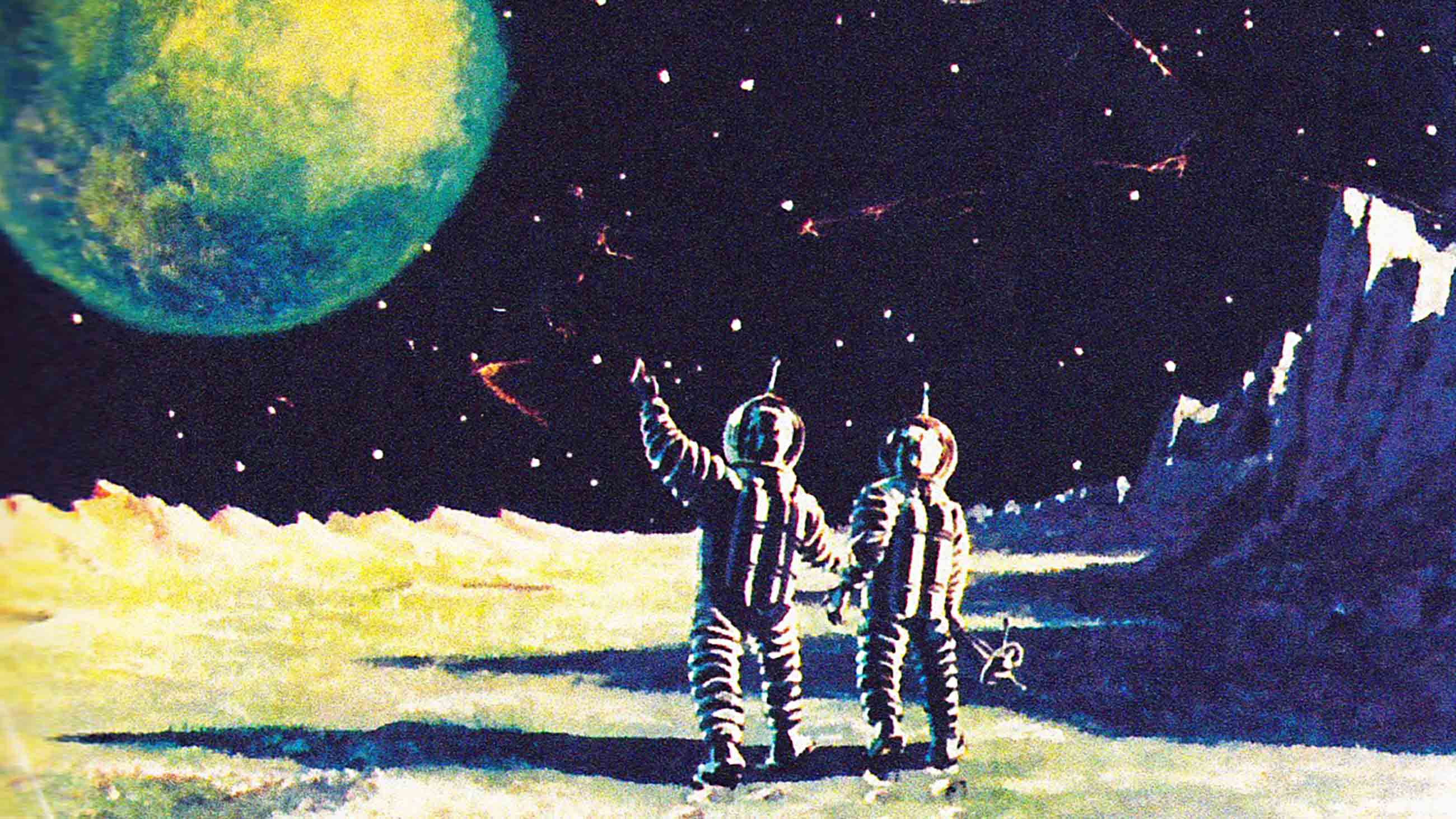In a 1961 documentary film showing Yuri Gagarin’s arrival in Moscow at Vnukovo airport following his heroic mission as the first man in space, everything is carefully arranged and staged: the red carpet on the tarmac, the crowd of spectators, Soviet leader Nikita Khrushchev waiting to welcome him home. All is perfect save for one detail. As Gagarin walks along the red carpet, all eyes on him, his shoelaces become untied.
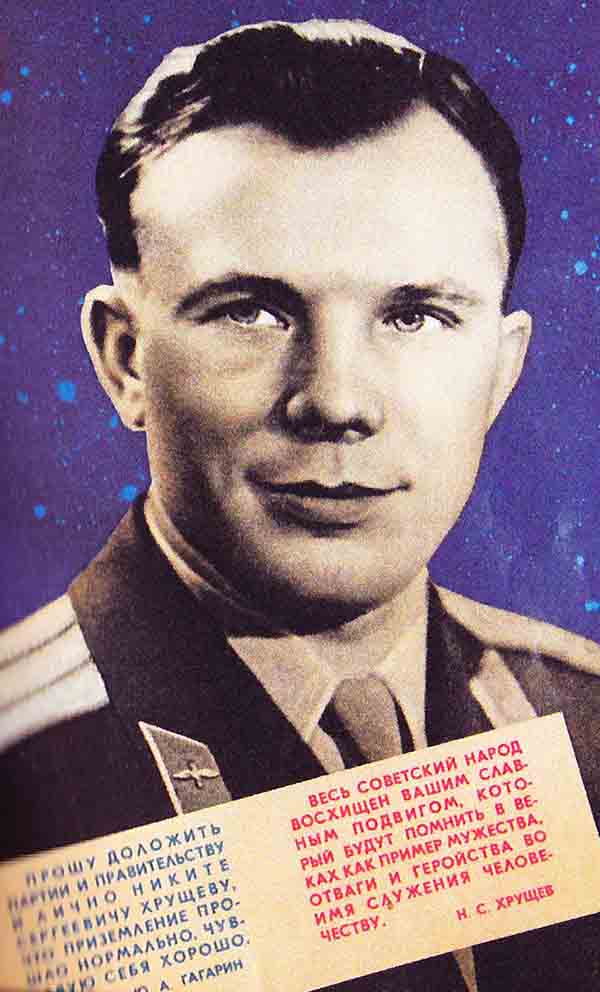
BOOK REVIEW — “Picturing the Cosmos: A Visual History of Early Soviet Space Endeavor,” by Iina Kohonen (Intellect/University of Chicago Press), 205 pages. Above, a 1961 portrait of the cosmonaut Yuri Gagarin in Ogonyok magazine.
It’s a random human moment in the midst of a meticulously planned spectacle. In his autobiography, Gagarin later described his thoughts: “What if I stepped on them and I fell on the red carpet? That would be really embarrassing. The people would laugh — ‘he did not fall from space, but instead tripped on flat ground…’”
As Iina Kohonen points out in her fascinating new book “Picturing the Cosmos: A Visual History of Early Soviet Space Endeavor,” Soviet media was controlled down to the smallest detail. The public perception of the Motherland’s space efforts was the product of a painstakingly curated narrative of Soviet triumph and exploration. “The cosmonauts were described … as ideal men, both physically and mentally…” Kohonen writes. So why was this awkward chink in the shining armor of the Soviet hero not edited from the film?
The answer demonstrates Kohonen’s major thesis: the importance and power of imagery in the space race, both politically and culturally, in the Soviet Union. The book examines how visual media served to construct an overarching heroic mythos of the conquering Soviet man, bravely exploring the depths of space, for the glory of the USSR and all mankind, and how that narrative was crafted to emphasize the values that Soviet leaders wanted to instill in their citizenry — while hiding uncomfortable realities and preventing attitudes at odds with the official line.
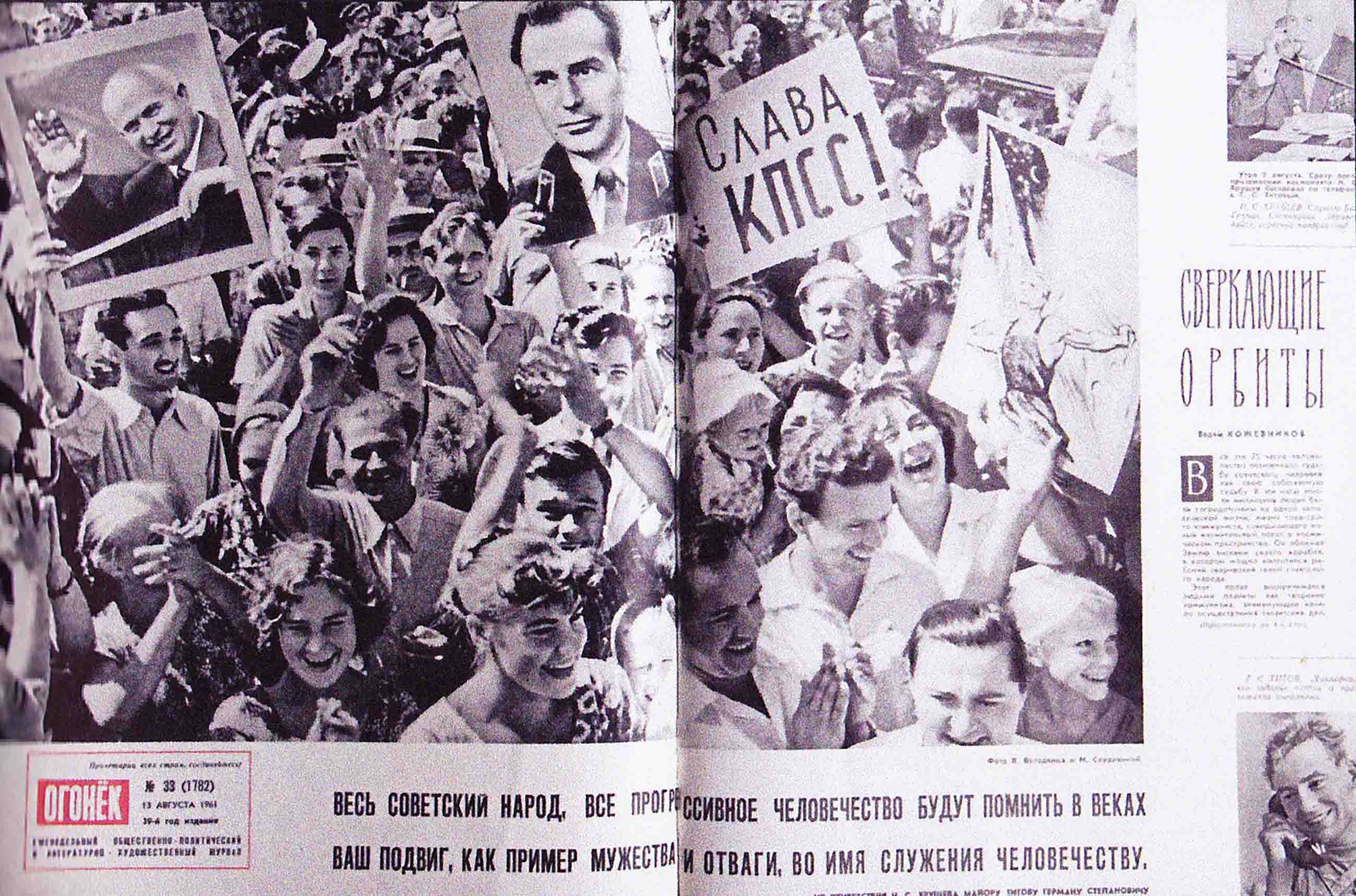
A cultural anthropologist and expert on the visual history of the Soviet space program, Kohonen concentrates on the archives of the popular weekly photo magazine Ogonyok, the Soviet equivalent of Life. If not always “fake news” in the 21st-century American sense of the term, the reportage of magazines such as Ogonyok was political propaganda, social control, and collective psychological anodyne all at once. “From the viewpoint of the present observer,” writes Kohonen, “the material … colored and modified the truth, covered faults, hid, and abjectly lied. The imagery connected to space in the Soviet Union cannot be examined as neutral photos taken for the press.”
Instead, the public image of the cosmonaut had to be honed to a fine edge of idealized reality. He was a stalwart military pilot, a devoted family man, a dedicated Communist. Those who failed to live up to these ideals were purged from public existence. Consider Grigori Nelyubov, who might have been the first man in space instead of Yuri Gagarin until he was drummed out of the cosmonaut corps for “bad behavior.” Kohonen shows how Nelyubov’s image was erased from photos after his fall from grace. And although women supposedly enjoyed full equality in Communist society, Soviet image makers had trouble dealing with the fact that female cosmonaut Valentina Tereshkova was single — at least until she was finally married off to another cosmonaut. Meanwhile, Tereshkova’s sister cosmonauts, none of whom ever flew, were never photographed or revealed to the public — hidden figures of the Soviet space program.
Yet reality could sometimes usurp the official mythology. Although “accidents or failures did not belong to the narrative of the victorious space program,” and those that were met “by those candidates still out of the public eye remained hidden from public view,” it was impossible to ignore the deaths of already publicized Soviet heroes, such as Vladimir Komarov, who died in a re-entry accident in 1967. But truth could still be de-emphasized and details obscured. “In Ogonyok, the case was glossed over with a brief obituary; the accident was not front-page news,” notes Kohonen. The major exception was the death of Yuri Gagarin in a 1968 flight training accident. But Gagarin’s mythic status also afforded a prime opportunity to exploit the tragedy to maximum effect with an elaborate state funeral. “Even Ogonyok admitted this: Gagarin had been closer to God than anybody else and was therefore a saint,” writes Kohonen.
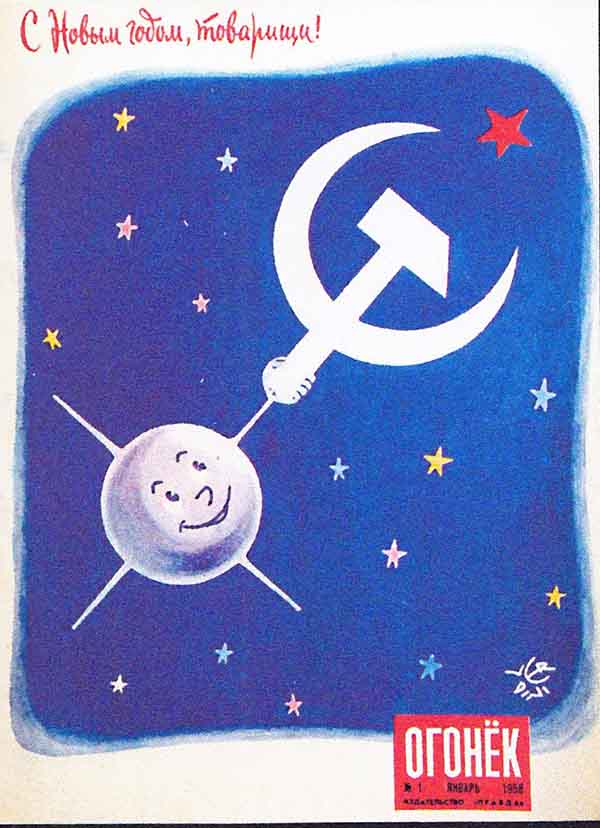
The cover of Ogonyok in January 1958. The caption reads, “Happy New Year, comrades!”
Visual: From "Picturing the Cosmos" (Intellect Books)
Reality intruded in other ways. Using imagery from its Moon-orbiting Luna 3 probe, the USSR had begun mapping the dark side of the Moon, naming previously unseen lunar features with terminology that was later officially accepted by the International Astronomical Union, the authority in charge of naming all celestial bodies. But this apparent triumph for Soviet science evaporated shortly thereafter, when more detailed imagery (some from the U.S.-manned Apollo missions) proved that two of the biggest findings that the Soviets had so proudly named didn’t actually exist and were only the artifacts of low-resolution photography. “The Soviet Union could not have lost the Moon Race in a more symbolic way,” Kohonen remarks.
The heart of Kohonen’s story in “Picturing the Cosmos: A Visual History of Early Soviet Space Endeavor” is, of course, the fascinating collection of images she has compiled. Some of them may be familiar to dedicated space geeks. But many more will be surprising and fresh, which makes it a shame that most of the 125 images are displayed in such small sizes that it’s often difficult to adequately appreciate the details that Kohonen describes in her analyses. And although each image is referenced in the text by number, some of the references are inaccurate, leading to occasional confusion. Still, the sheer number of images and Kohonen’s astute commentary help compensate for these lapses.
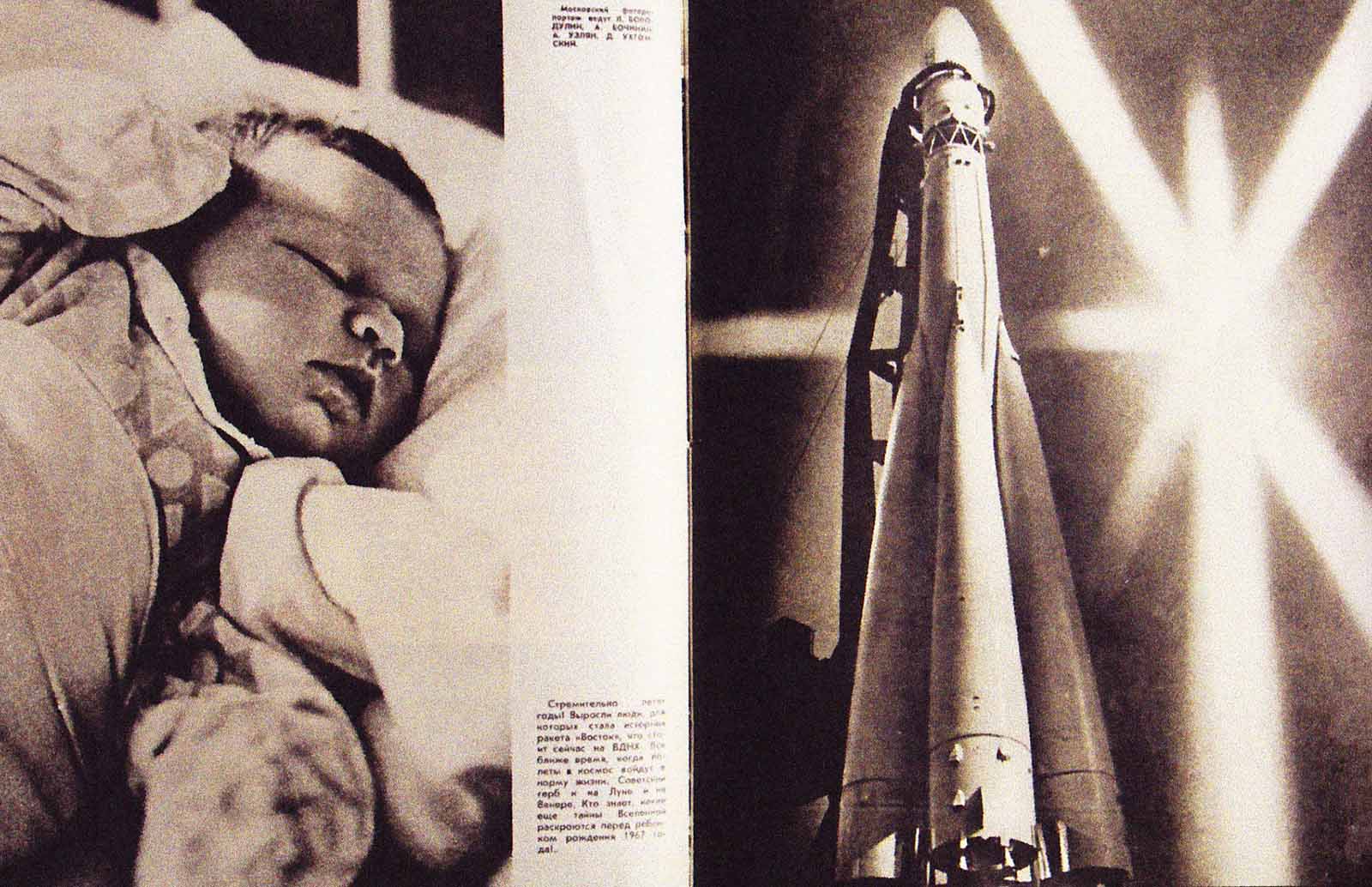
And what of Gagarin’s shoelaces? Kohonen shows that it’s a rare example of truth being adopted to serve the heroic narrative. “The shoelaces becoming untied was certainly a mistake, but leaving the detail in the film was not,” she concludes. They were “a happy slip that was taken as part of the story. Through the shoelaces, Gagarin’s humanity, ordinariness, and fallibility were emphasized.”
But other inconvenient truths continued to be excised from public consciousness. Kohonen found the same scene included in a film from the late 60s, years after Khrushchev had been ousted from power. Gagarin’s shoelaces are still untied. But the since disgraced nonperson Khrushchev had been edited out.
Mark Wolverton is a science writer, author, and playwright whose articles have appeared in Undark, Wired, Scientific American, Popular Science, Air & Space Smithsonian, and American Heritage, among other publications. His most recent book is “A Life in Twilight: The Final Years of J. Robert Oppenheimer.” In 2016-17, he was a Knight Science Journalism fellow at MIT.










